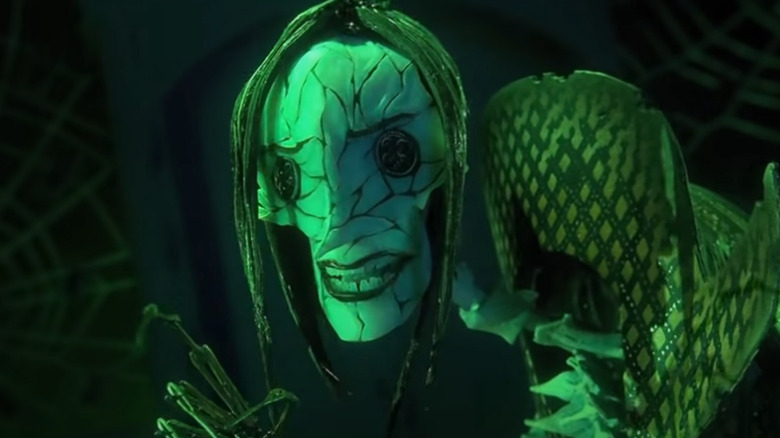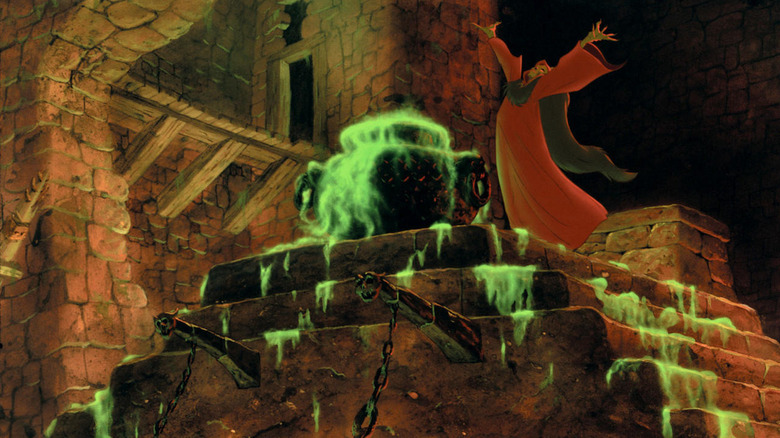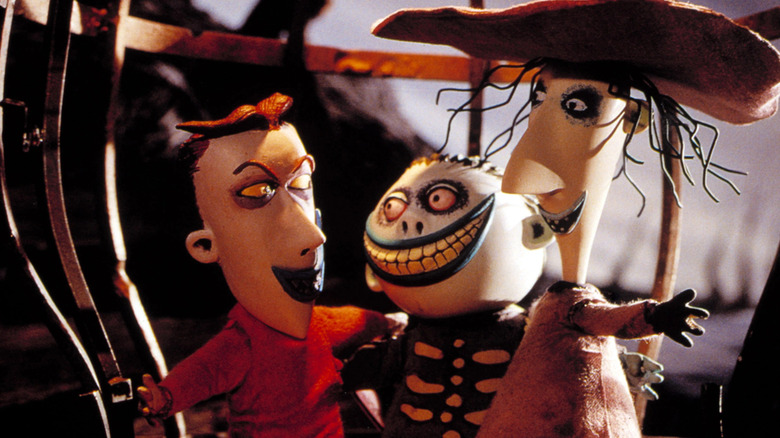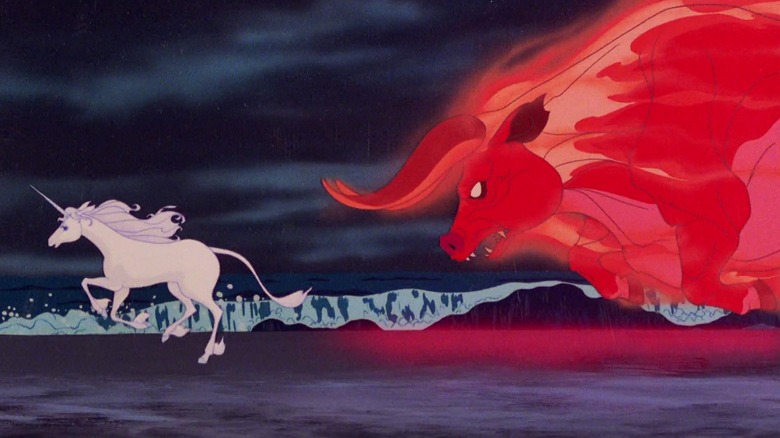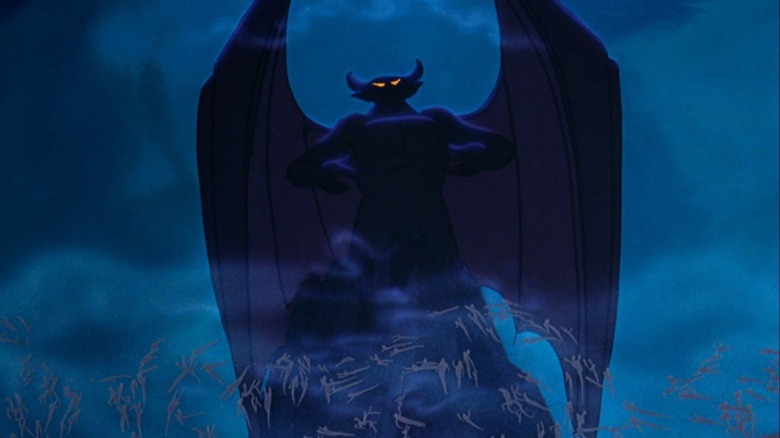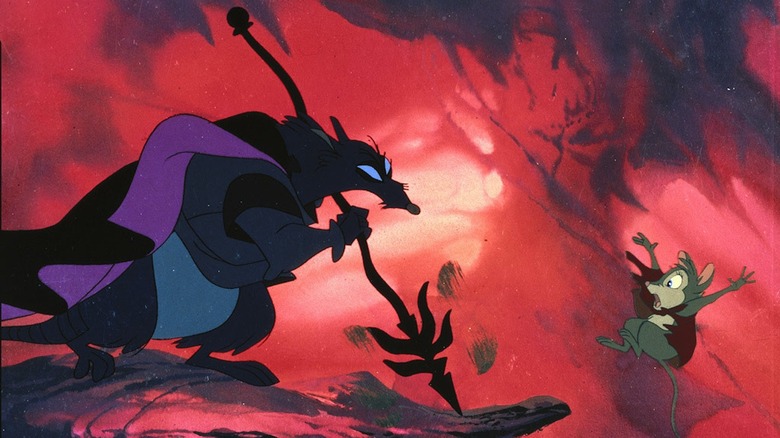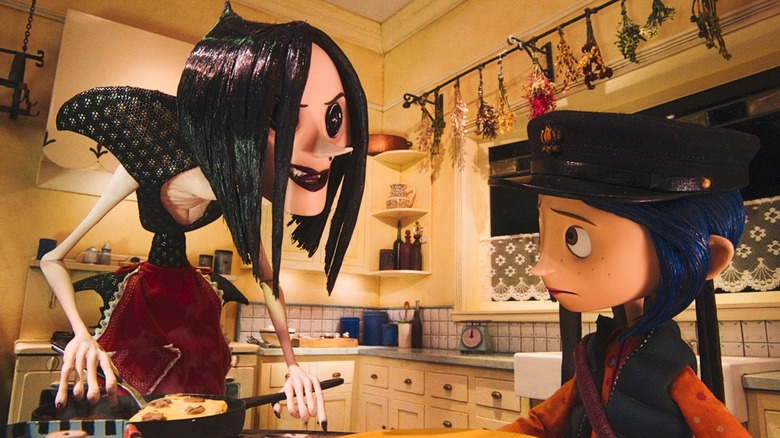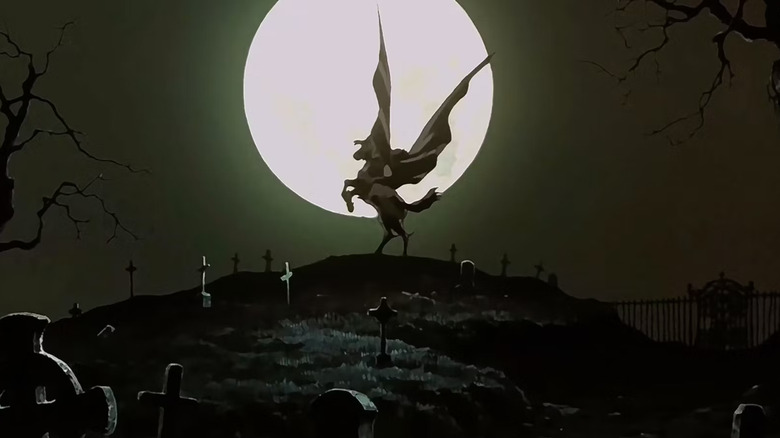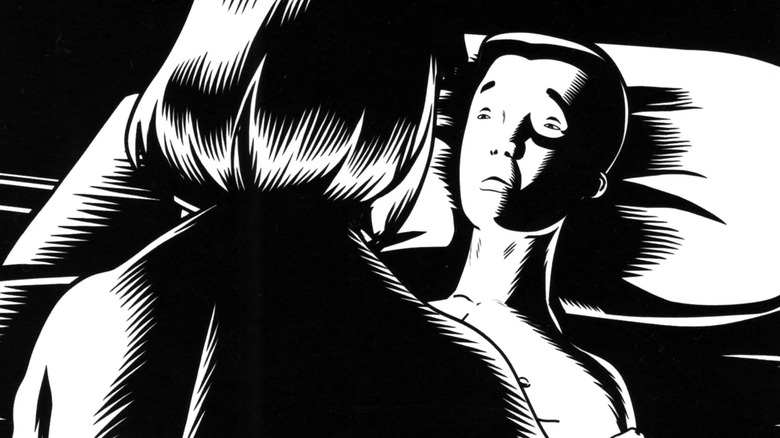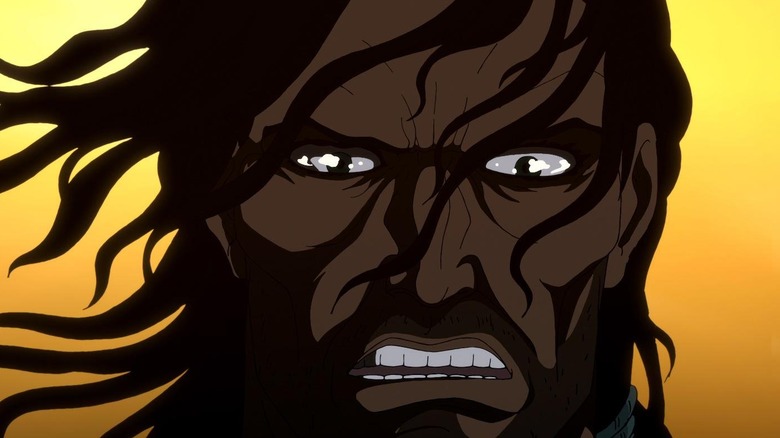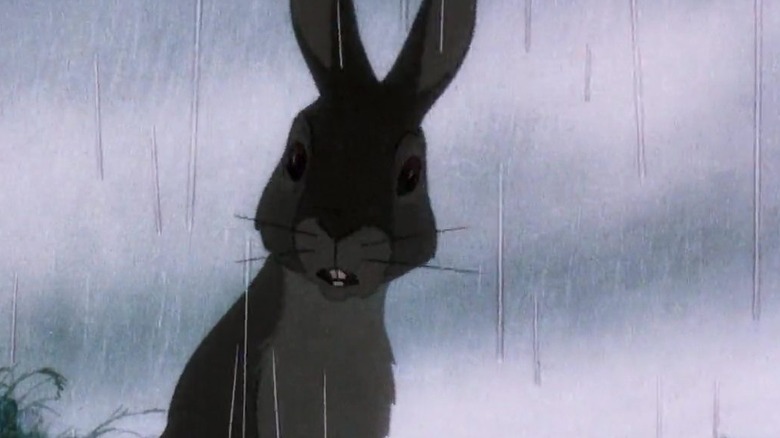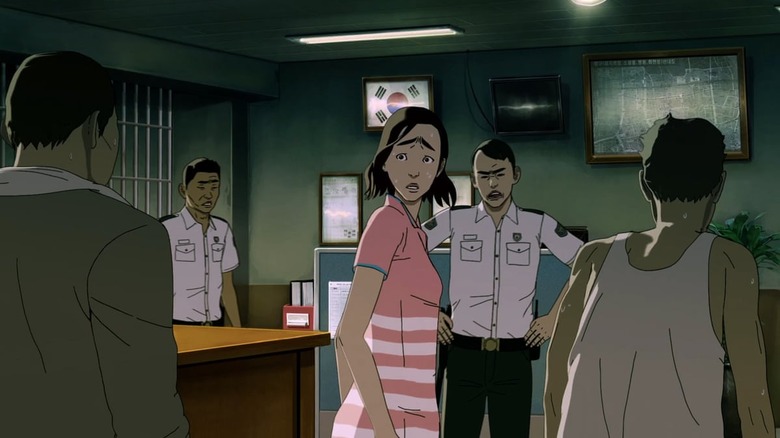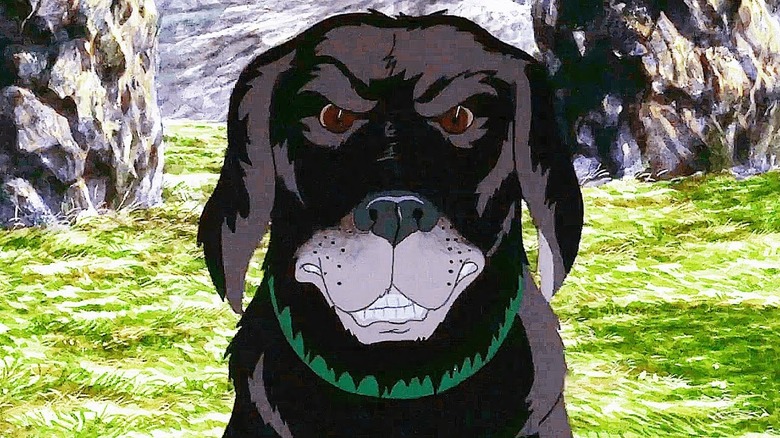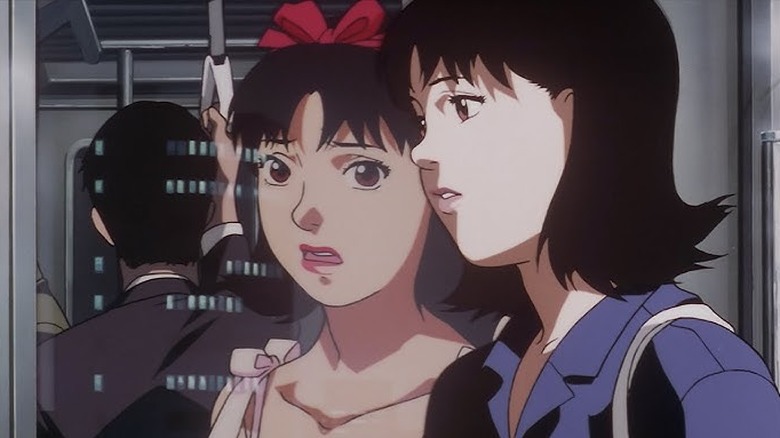The 13 Scariest Animated Movies
Too often, animated movies are written off as silly children's fare, but the medium is more than capable of scaring even the most hardened adult. From Disney classics to anime horror fests, animated films have been responsible for plenty of nightmare fuel. So as we count down the days to Halloween, let's count down the scariest animated movies (using that unlucky number 13, of course).
Here are the scariest animated films, which include some familiar childhood horrors, some harrowing horror movies targeted at adults, and a surprising amount of John Hurt.
13. The Black Cauldron
"The Black Cauldron" is probably one of the films that Disney wished audiences could forget, mostly because it literally scared audiences away from theaters. Released in 1985 as part of Disney's push toward darker material, "The Black Cauldron" was a massive box office bomb that nearly toppled the House of Mouse's entire animation wing. But I say that this deeply weird movie is unfairly reviled.
Loosely based on the first two books in "The Chronicles of Prydain" by Lloyd Alexander, "The Black Cauldron" is nothing at all like its source material, but it's also nothing like what Disney had done before. The film follows a young pig keeper named Taran who teams up with the princess Eilonwy, a bard Fflewddur Fflam, and a wild creature named Gurgi to stop the Horned King from raising an army of the undead and conquering the world. To do this, they must destroy the titular black cauldron, which only Taran's prophetic pig can locate. The movie is kind of a mish-mash of tones and animation styles — the latter of which a young Tim Burton contributed to — and features a nonsensical plot, but there's no denying just how eerie "The Black Cauldron" is. The majority of the horror comes from the creepy design of the Horned King who, despite looking like a scarier version of Skeletor, is a genuinely chilling villain thanks to the performance of John Hurt (who will be showing up a lot on this list).
12. The Nightmare Before Christmas
You knew this would be on the list. "The Nightmare Before Christmas" is the movie that you quote endlessly as an adult, but probably won't admit gave you nightmares as a kid. I've featured this ghoulish stop-motion movie on this column before, but I'd be remiss to not feature it again.
Remember Tim Burton from the last entry? Well, after the disastrous failure of "The Black Cauldron," Burton was so traumatized that he nearly fled animation altogether, heading to the live-action realm where he made his name with acclaimed films such as "Beetlejuice" and "Batman." But the call of animation was too strong for the idiosyncratic filmmaker, and he ended up finding his way back to the medium — and back to Disney, no less. But not as the director. Burton produced and conceived of 1993's "The Nightmare Before Christmas," with the directorial duties going to stop-motion visionary Henry Selick ("James and the Giant Peach," "Coraline"). Together, they created the bane of our childhood memories. (Though I was personally too scared of it that I didn't dare watch it until I was an adult. But the commercials terrified me!) "The Nightmare Before Christmas" follows the Pumpkin King of Halloween Town, Jack Skellington, as he kidnaps Santa Claus and tries to bring the two holidays together, resulting in chaos around the world. To have a skeleton as the protagonist is frightening enough, but the unnerving body horror that occupies every frame of this movie — Sally's stitches, the Mayor's gaping smile, Barrel's bulging eyes — is enough to send any kid screaming.
11. The Last Unicorn
Two words: The Red Bull. Nothing makes a scary movie like a good monster, and "The Last Unicorn" has one of the most terrifying animated monsters of all. At first glimpse, the fantasy epic doesn't seem outright scary though it is a little weird. Released in 1982, "The Last Unicorn" was a Japanese-American production based off the novel by Peter S. Beagle that told the story of a unicorn who discovers that she is the last of her kind as the others have all vanished. She sets off on a quest to get them back, but her road is beset by all sorts of dangers, each more threatening than the last. She gets kidnapped by a hag who forces her to become a carnival curiosity, she meets a harpy whose horrific character design and screeching dialogue would be enough to get this movie on the list. Oh, and there's a tree with heaving breasts — though I guess that's a little more on the disturbing side than the straight-up scary.
But it's all leading up to the Red Bull, who was pure evil made manifest. With its deep blood-red color and surrounding cloud of smoke, the Red Bull is simultaneously ethereal and tactile — an unstoppable force for which there are no immovable objects. But fascinatingly, the Red Bull's master, King Haggard, is just as terrifying in a drastically and innately human way. King Haggard and his motivation evoke a feeling of existential dread that is unusual for a fantasy film, and even more so for a children's film.
10. Fantasia
If you weren't traumatized as a kid by the Chernabog in the 1940 "Fantasia," then you can get the f*** out of here. Sorry for the language, but that demonic creature in the final segment of Disney's experimental musical film is terrifying enough to provoke a primal response from anybody — okay maybe just from me. Even to this day, watching this segment (I swear, I got war flashbacks when I so much as searched the above clip) will reduce me to a blubbering mess. It's astonishing that the "Night on Bald Mountain" segment, as well as all the other animated segments set to classical music that comprise "Fantasia," came so early in the Walt Disney Company's lifespan. Disney's third animated feature film was also one of its scariest (though shout-out to "Pinocchio's" donkey boys for laying the foundation).
I single out "Night on Bald Mountain" — which centers on the devil Chernabog summoning hordes of evil spirits and ghosts from their graves to Bald Mountain, set to a live orchestra playing "Ave Maria" by Franz Schubert — but each of the animated segments in "Fantasia" are dark in their own ways. "Rite of Spring" shows the birth of the universe as well as the reign and extinction of the dinosaurs, while the much-beloved "Sorceror's Apprentice" starring Mickey Mouse features some very scary brooms.
9. The Secret of Nimh
Nobody does melancholy animated flicks quite like Don Bluth, and "The Secret of Nimh" is the animation legend at the top of his game. The No. 1 entry under the TV Tropes' Nightmare Fuel page, "The Secret of Nimh" was the source of many childhood nightmares because of its grim and bloody adventure story as well as the sheer feeling of dread that the film instills. The first feature under Bluth's Don Bluth Productions, which the animator founded after becoming disillusioned with his former employer Disney, "The Secret of Nimh" is a curious animated film. It straddles the line between children's adventure and alarmingly dark drama — a balance that Bluth would return to time and again with each of his future films. But "The Secret of Nimh" is still his finest, or at least most frightening, work.
"The Secret of Nimh" follows a widowed field mouse, Mrs. Brisby, as she attempts to shield her children from the oncoming destruction of a tractor. The life-and-death stakes are upped when Mrs. Brisby's child Timmy is deemed too sick to leave his bed, which forces the timid field mouse to find other means to save her family, leading her to discover the titular "secret" of the farm. The simple premise conceals a complex backstory that delves into animal experimentation, political infighting, and a really gross-looking owl. The combination of traditional 2D animation and rotoscoping adds to the movie's uncanny atmosphere, making the random bits of blood and violence more distressing. An owl crushing a spider never looked so gruesome.
8. Coraline
Here's where we start to move past childhood trauma and into real adult fears. "Coraline" is ostensibly a children's movie, but oddly, it's adults who find this dark fantasy horror film the most disturbing.
And it's easy to see why. Those button eyes! That creepy element introduced in the latter half of "Coraline", which follows a bored young girl who stumbles upon an idealized parallel world through a portal in her bedroom, is enough to send shivers down anyone's spine. The film unfolds like a horror film, with the mood steadily growing more sinister as the titular Coraline is faced with cryptic warnings and frightening dangers. The formerly bright alternate worlds peels away to reveal a tightly controlled illusion, complete with hapless doppelgangers controlled like puppets and a great big scary spider villain.
7. Vampire Hunter D: Bloodlust
Anime horror maestro Yoshiaki Kawajiri directs this gorgeous entry in the "Vampire Hunter D" saga, based on Hideyuki Kikuchi's series of fantasy sci-fi novels. "Vampire Hunter D: Bloodlust" has a rather clunky name, but this handsomely animated is anything but. Part spaghetti western, part Gothic vampire story, part star-crossed romance, "Vampire Hunter D: Bloodlust" is a ridiculously stylish anime film that doesn't let up on the gore and bloodshed. Set in a post-apocalyptic future where humans rule the day and vampires reign supreme in the night, "Vampire Hunter D: Bloodlust" centers around the titular human-vampire hybrid D, who is kind of like a really pretty Blade: a vampire hunter who is treated as an outcast by both races. Hired by a millionaire to find his daughter who had been kidnapped by vampires, D sets off into the vast wastelands where he is attacked by bloodthirsty vampires and rival bounty hunters with a grudge against him.
Despite the convoluted-sounding mythology, "Vampire Hunter D: Bloodlust" is a pretty simple road movie that Kawajiri packs with visual flourishes and inhumanly beautiful characters. The film can sometimes veer more toward style than substance but boy, is it great to look at. Plus there are the grisly horror elements, which could be over-the-top for some, but are perfect for genre fans looking to get into anime.
6. Fear(s) of the Dark
You'd expect a few scares from a horror anthology film titled "Fear(s) of the Dark," but what you probably wouldn't expect from this 2007 French black-and-white animated experiment is just how unsettling it is. There are no jump scares, no sudden outbursts of bloodshed. Instead, "Fear(s) of the Dark" burrows under your skin and lays mutant insect eggs that eventually transform into anthropomorphic monsters that consume you body and soul. Yes, that is the plot of one of the five stories that comprise this film — written and directed by "Black Hole" author Charles Burns with his signature dose of body horror — and yes, it shook me to my core.
There is a segment that is merely a few minutes of ponderous narration set to computer-animated shapes, and another where a young girl is tortured inside and outside of her nightmares. The five stories are each written and directed by notable comic book creators and graphic designers including Burns, Italian comics artist Lorenzo Mattotti, "Here" author Richard McGuire, and French graphic artist Marie Caillou. They range from bone-chilling to flat-out horrifying, with some animated by hand and others by computer, but all sharing the same black-and-white palette. This stark color scheme (or lack thereof) makes "Fear(s) of the Dark" sometimes feel more like an experimental exercise cobbled together by a group of graphic novelists, but that's what sets "Fear(s) of the Dark" stand apart from other horror anthologies.
5. Watchmen: Tales of the Black Freighter
One of the difficulties of adapting a dense tome like "Watchmen" are some of the nuances lost in the process. One of those nuances lost in Zack Snyder's otherwise suffocatingly loyal feature adaptation of Alan Moore's seminal graphic novel was a whole narrative unto itself: a side story in which a young boy reads a disturbing pulp pirate novel at a news stand. And thanks to the joy of special features, that side story got repackaged into an animated short film titled "Watchmen: Tales of the Black Freighter." A comic within a comic, "Tales of the Black Freighter" was initially interspersed with the main narrative of "Watchmen," with Moore using this nihilistic pirate's tale to build the graphic novel's bleak overall atmosphere.
As a result, the 30-minute short film for "Tales of the Black Freighter" feels a little half-baked, but it's still just as effectively sinister. The film follows the lone survivor (Gerard Butler) of a pirate attack, who floats to a deserted island on the wreckage of his ship and his fellow sailors' dead bodies. Driven mad by isolation and the paranoia that the pirates were heading to his hometown, the unnamed Sea Captain desperately builds a raft out of spare bits of wood and corpses. He sets sail on his grotesque vessel, along the way slowly transforming into something just as horrific. The short film has the clever addition of a sort of monstrous Wilson from "Castaway," in the form of the mottled corpse of the Sea Captain's first mate Ridley. Voiced by Jared Harris in nightmarish dream sequences, Ridley tips the scales for "Tales of the Black Freighter" from being simply an accomplished adaptation of a "Watchmen" side story into a harrowing short film that stands on its own.
4. Watership Down
By now you've probably heard countless anecdotes and or read the hilarious Amazon reviews in which an unsuspecting parent buys "Watership Down" for their kids expecting a cute film with rabbits only to discover quite the opposite. Relentlessly grim and shockingly violent, "Watership Down" is a bedtime story turned nightmare. Director-writer Martin Rosen adapts Richard Adams' classic novel of the same name in this 1978 animated adventure about a group of rabbits who flee their warren in fear of an apocalyptic vision. This list's favorite voice actor John Hurt stars again as Hazel, the protagonist who reluctantly takes on the role of the group's new chief, and leads them to a prophesied utopia with the help of his seer younger brother, Fiver (Richard Briers). But in a world where rabbits are cursed to be the most vulnerable creatures, the scrappy group is besieged by all sorts of vicious dangers that threaten their lives and our mental well-being.
This is a stressful movie, folks. The dangers never abate for these rabbits, and despite "Watership Down's" epic narrative, the film feels painfully tactile. Even when the film descends into a gratuitous gore-fest with the showdown with the cruel chief, General Woundwort (whose battered and bloody face is the iconic disturbing image slapped onto every YouTube reaction video to this film), the rabbits never feel anything less than human. "Watership Down" is the evolution of the fable — an animal-led parable meant to evoke sympathy and provoke thought. Even if most of the thoughts it provokes are, "Oh god, make it stop."
3. Seoul Station
"Train to Busan" is a pitch-perfect zombie movie that transformed a barebones premise into a goddamned genre masterpiece. Did it need a prequel? No. But are fans going to watch the hell out of one? Oh yeah. "Train to Busan" director Yeon Sang-ho somehow found the time to direct an animated prequel to his 2016 zombie hit that astonishingly manages to throw even more twists and social satire into the standard zombie narrative. Titled "Seoul Station" (in keeping with the train theme), this animated feature film follows the outbreak of the zombie virus that soon overtakes all of South Korea, evidently tracing the virus to a homeless man bleeding to death near the titular station. The movie then picks up with various characters — a young runaway woman, her hapless boyfriend, a father searching for his daughter — who soon are forced to run for their lives from the mysterious ravenous zombies. "Seoul Station" is more sprawling than "Train to Busan," which both helps and hinders it.
It takes its time to set up its various plot threads and introduce some pretty unsympathetic characters, but once it gets going, "Seoul Station" barrels relentlessly toward its doomed conclusion. The suspenseful set pieces and emotional narrative are on par with "Train to Busan," culminating in a fantastic jaw-dropping twist.
2. The Plague Dogs
"The Plague Dogs" completes the John Hurt trifecta of animated movies that make us feel really bad. But this Martin Rosen film, also adapting another Richard Adams novel of the same name, is a special kind of miserable. "The Plague Dogs" opens with an appalling scene of a dog being drowned and resuscitated at a laboratory experimenting on animals. It's the kind of bald-faced horror that sets the tone for the rest of the film: harrowing and disquieting, but worst of all, overwhelmingly hopeless. The 1982 film follows two dogs, a Labrador-mix named Rowf and a smooth fox terrier named Snitter, who escape the animal research facility where they had been tortuously experimented on, fleeing through a merciless countryside where they're bombarded by the elements and later, hunted down by the military following the facility's dispensing of rumors that they carried the bubonic plague.
The majority of the film is essentially watching these two poor dogs starve to death, despite their best efforts to live by hunting grazing sheep and ransacking village trash cans. "The Plague Dogs" is perhaps the greatest testament to nihilism there is, apart from the equally depressing "Grave of the Fireflies" (if I wrote a column on most despairing animated movies, those two would top the list). "Plague Dogs" doesn't fall under the traditional definition of "scary" per se — you'll find precious few jump scares or pulse-pounding scenes — but makes it to the near-top of this list because of its oppressive, abject misery.
1. Perfect Blue
You aren't really reading this entry about "Perfect Blue." You imagined that you read it, in a dream, or maybe you're an actress playing the writer who wrote this entry. And maybe your producer is trying to kill you. Satoshi Kon's directorial feature debut is a bona fide masterpiece in a filmography full of masterpieces (this is the anime legend behind the famous "Paprika"), but "Perfect Blue" is the one that manages to sit with you for the longest.
The 1997 psychological thriller seamlessly blends fantasy and reality in a story about a pop star, Mima Kirigoe, who retires from her J-pop girl group to attempt a career as an actress. But Mima's bright new career move is disrupted upon her discovery of a website that catalogs her every move, as well as the appearance of a stalker unhappy with her shedding her teen idol image. Kon is a director obsessed with the duality of humans, and he interrogates that at full force in "Perfect Blue." The film is a paranoid descent into the madness of a girl who struggles to reconcile her image as a pop idol and with her image as a serious actress, until her personas themselves manifest into real, dangerous beings. Or so you think. "Perfect Blue" is a breathlessly disorienting film, embedding the viewer so deeply in the mind of Mima that it's impossible to tell what is real, even when a camera is pointed at her. But, of course, that shaky grasp on reality isn't the scariest thing about this movie.
"Perfect Blue" is deeply violent, both physically and emotionally. There's way more bloodshed than you'd expect in a film about an actress losing her grasp on reality, and the film contains one of the most explicit assault scenes ever put to celluloid. This is a film that will leave you with profound psychological scars, and the feeling that you want to take a long, long shower.
